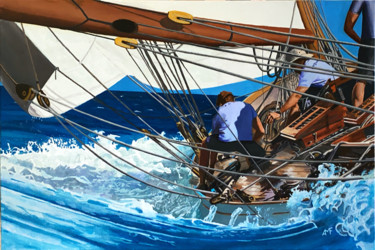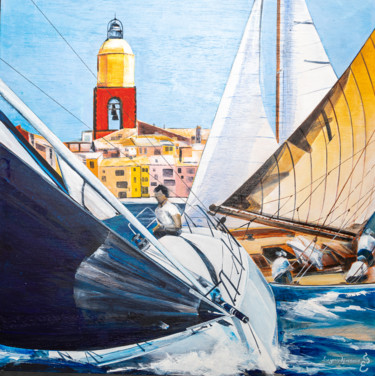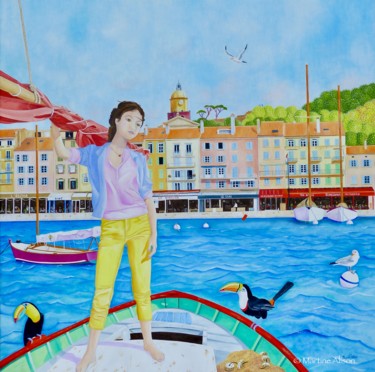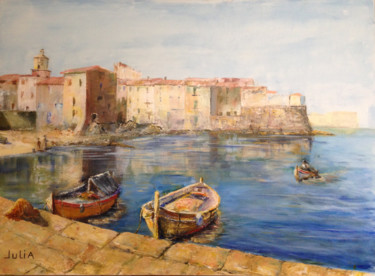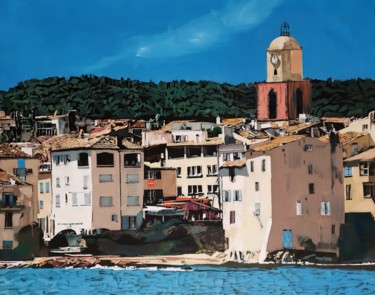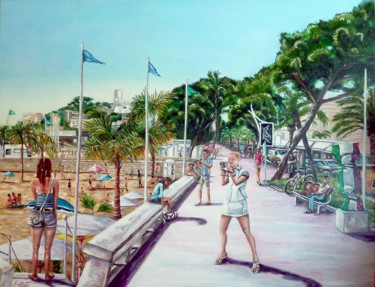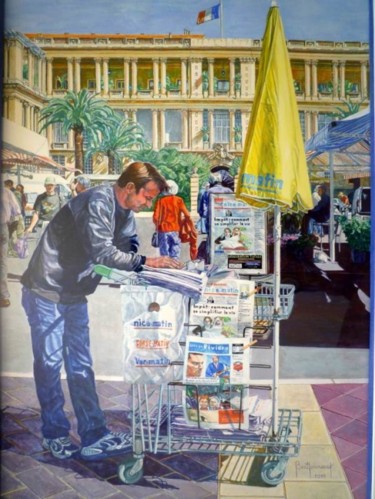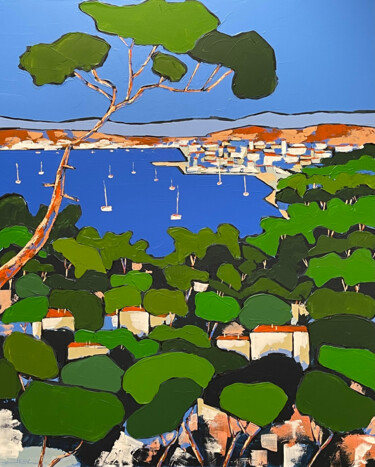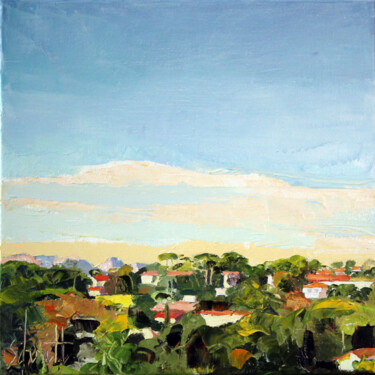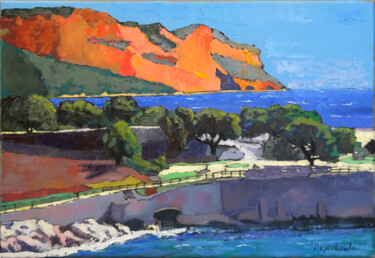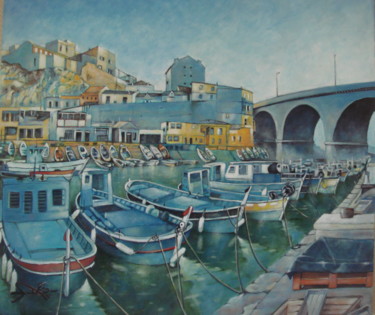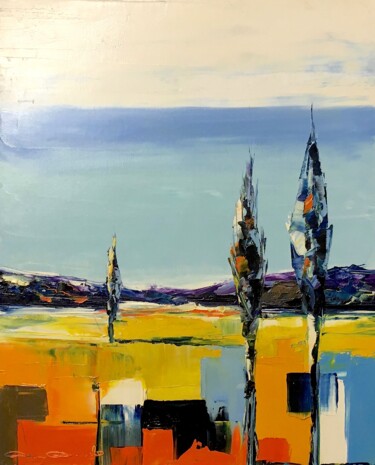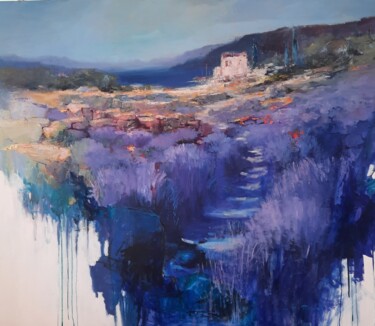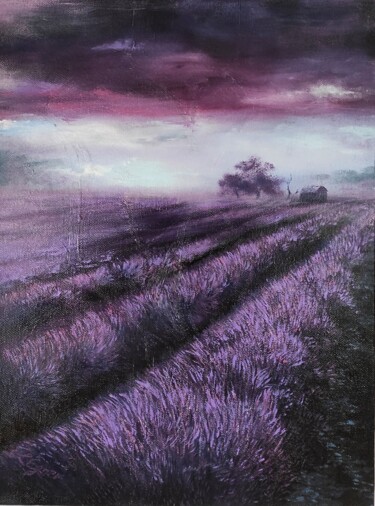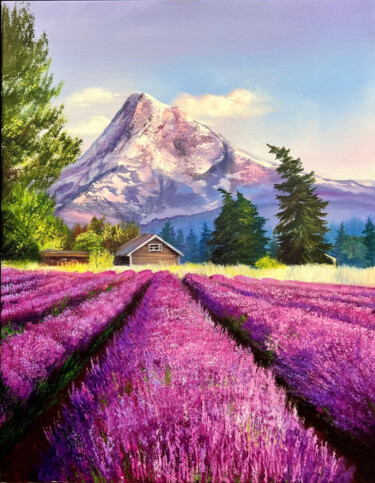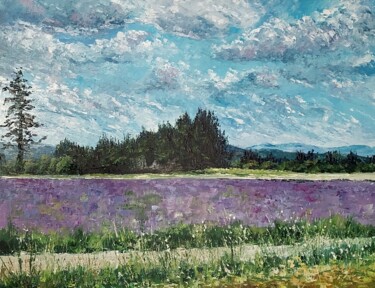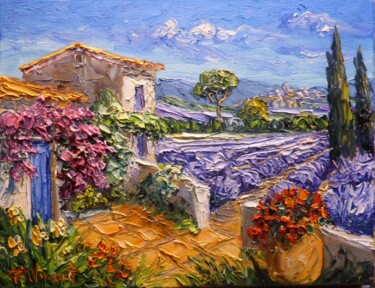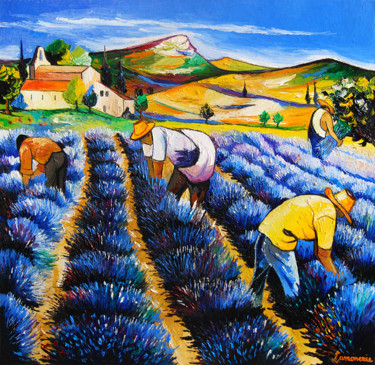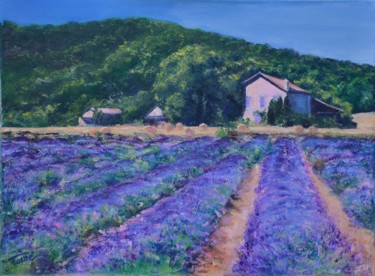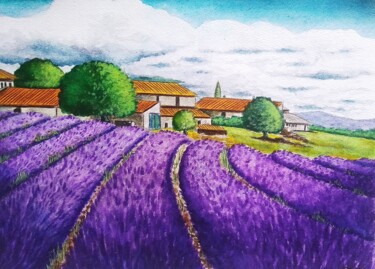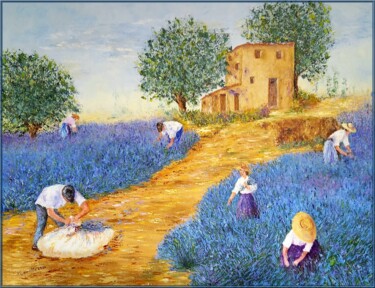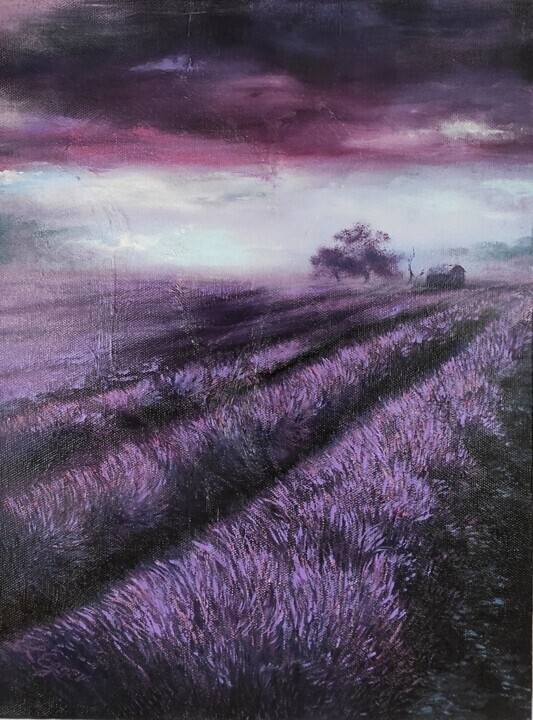 LAVENDER STORM (2017)Painting by Larissa Egner.
LAVENDER STORM (2017)Painting by Larissa Egner.
Provence: moving from Dante to Cézanne and Van Gogh
The charm of Provence can be described in words, in poems, sometimes in music, as well as through the silent, but certainly impactful and highly expressive, medium of painting, aimed at tinging the colors of a land kissed by the sun, colored by lavender and embellished by sea salt. Beginning with the written verb, I present the aforementioned region of southeastern France, washed by the Mediterranean Sea, extending from the left bank from the lower Rhone River westward almost to the border with Italy, as a center of important historical and artistic interest, in that it, in addition to having welcomed Greek colonies, underwent an intense process of Romanization, which favored, in the later medieval era the development of a refined civilization, the culmination of which was manifested at the turn of the 12th and 13th centuries, a period whose fame also earned it a mention by Dante Alighieri, who evoked the Provençal poet Arnaut Daniel, who, highly respected by the Tuscan, had the privilege of being able to express himself, within Dante's Purgatory, in his mother tongue, namely Occitan. Finally, the account written about this region of France concludes in the evocation of the most typical postcard memories that such a location offers us, certainly embellished by the scent and color of its most typical lavender, a plant, which, together with the stunning landscapes wisely placed on the coast and the historical-artistic assets, make Provence one of the great destinations of international tourism. Postponing the poetic description of the above-mentioned place to another occasion, I proceed with a double quote: "The sunlight here is so intense that it seems to me that the silhouettes of objects are not only black and white, but also blue, red, brown and violet" and "I immerse myself in the landscape daily, the beauties I see make my days more pleasant than anywhere else." words uttered by the well-known master Cézanne, aimed at summarizing the reasons why other artists, such as Van Gogh, Matisse, Chagall, Picasso, Klee and others, also elected Provence as a place of choice for painting practice.
 "LAVENDER EVENING" (2021)Painting by Margarita Kovalenko.
"LAVENDER EVENING" (2021)Painting by Margarita Kovalenko.
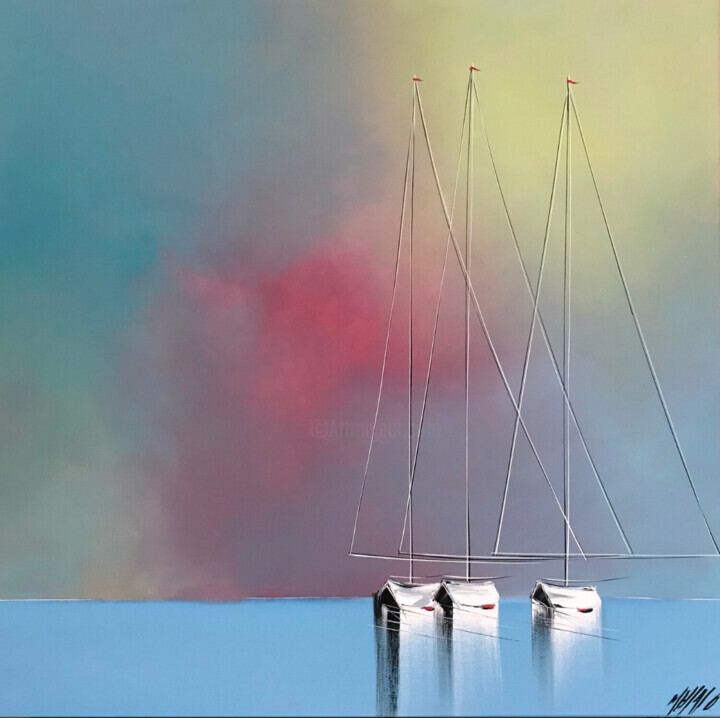 JAMAIS DEUX SANS TROIS… (2020)Painting by Olivier Messas.
JAMAIS DEUX SANS TROIS… (2020)Painting by Olivier Messas.
The Provence of Cézanne and Van Gogh
The relationship between the French region and art became more concrete in the figurative investigation of Cézanne and Van Gogh, artists within whose oeuvre images of Aix-en-Provence, Arles and Saint-Rémy-de-Provence often appear. Starting with the older of the two painters, Cézanne is certainly known for his multiple representations of the Mountain of Sainte Victoire ( Aix-en-Provence), a mountainous massif whose depiction tells not only the features of Provence, but also the stylistic evolution of its creator, who arrived, progressively, at the sort of decomposition of figures into solid geometric forms, as well as the interpenetration of sharp planes, that characterized the later Cubist current. What has just been stated can be evidenced by comparing four different works, depicting the above-mentioned naturalistic subject matter, namely, Mont Sainte-Victoire and the Viaduct of the Arc River Valley (1882-85), Mont Sainte-Victoire with Large Pine (1887), Sainte-Victoire Mountain (1904-1906), and Sainte-Victoire Mountain (1905-1906). In these masterpieces the mountain massif is always immortalized from below and from a distance, that is, from a vantage point that allows the master to isolate the brightness of the mountain, a "silhouette" that is gradually dematerialized along with the surrounding landscape, culminating in the last masterpiece mentioned above, in which the artist proceeds in the simplification of the rendering of the natural datum, realized by means of decomposed volumes, which appear to be chromatic pieces arranged next to each other, which, only when placed side by side, are capable of constituting a recognizable image. If I have given Cézanne the task of describing Aix-en-Provence to us, Van Gogh can assume the responsibility of synthesizing the atmosphere of Saint-Rémy-de-Provence through masterpieces of the caliber of Starry Night, while his account of Arles will be entrusted to the analysis of three less popular works, which I have chosen precisely for the purpose of acquainting you with them. First among them is The Harvest, an oil on canvas from 1888, aimed at telling us about the rural life of the aforementioned locality, described through the depiction of a field of wheat, which, already partially reaped, presents a band of golden stalks leaning against the fence that delimits an area of vegetation, while at various points are arranged the peasants at work under the intense Provençal sun, placed in a clear sky that allows a good glimpse of the mountains on the horizon. Speaking of urban life in Arles, on the other hand, is The Trinquetaille Bridge (1888), a masterpiece that immortalizes the metal and angular infrastructure of the same name, which crossed the Rhone River to unite the two sides of the French city, chosen by the Dutch master for its quietness, due to a sharp reduction in commercial traffic on the aforementioned river because of the subsequent development of the railroad network. In conclusion, The Inner Courtyard of the Hospital of Arles (1889) tells us, at least in part, about Vincent's "social life" in Arles, immortalizing a part of the Hotel-Dieu, i.e., the place where Van Gogh was forcibly hospitalized between December 1888 and May 1889, following the most famous ear cutting in art history. Finally, briefly describing the masterpiece, it depicts the aforementioned courtyard presenting a wealth of details, including the presence of a round fountain around which flower beds have been painted, as well as some trees with twisted branches and a dirt road, which separates the garden from the hospital's arcades. Within this space "the social life of Arles" is realized through the depiction of the presence of some patients, intent on walking under the porch or on the balconies. The iconic narrative linking Cézanne and Van Gogh to Provence continues in the works of Artmajeur artists, such as those of Jacques Peyrelevade, Sergio Lanna and Mirek Kuzniar.
 VIEW OF THE SEA FROM THE ROOFTOPS OF CAP D'ANTIBES (2022)Painting by Jiel.
VIEW OF THE SEA FROM THE ROOFTOPS OF CAP D'ANTIBES (2022)Painting by Jiel.
 SAINTE VICTOIRE (2023)Painting by Jacques Peyrelevade.
SAINTE VICTOIRE (2023)Painting by Jacques Peyrelevade.
Jacques Peyrelevade: Sainte Victoire
The Provençal painter Peyrelevade, depicting the subject of the Mountain of Sainte Victoire, places himself in direct dialogue with the highest tradition of art, as he cites Cézanne, presenting himself as a kind of contemporary pupil of the well-known French master. In fact, the expressionist painter of Artmajeur, whose work is mainly aimed at portray Provence, but also Marseille, the Mediterranean and the East, is fervently convinced that there cannot be an artist, who has not assimilated, even at an unconscious level, the infuence of the most celebrated exponents of the art world, even ending up reproposing, on some occasions, some specific stylistic, technical or subject expedients. In any case, despite the fact that the Sainte Victorie massif was "stolen" from Cézanne's brush, the artistic technique proposed by Peyrelevade turns out to be more akin to that of certain Provençal masters, recognized by the painter himself in the figures of Monticelli, Jean-Baptiste Olive, Marquet, Camoin, Verdilhan, Seyssaud, Ambrogiani, Toncini, etc. Yet, it is possible, thanks precisely to the subject matter, to compare the Artmajeur artist's painting to one of Cézanne's more "realistic" versions of the massif, such as the one titled Mont Sainte-Victoire seen from Bellevue (1885), in which, similarly, the colors generate a heavy and poorly worked chiaroscuro, which is arranged on the rocks and hillsides. Certainly, subject matter, shadows and framing aside, the "fauves" colors used by Peyrelevade, aimed at animating a subject, which, though largely exploited by art history, has been given a new life and new pictorial interest as a gift.
 VINCENT AT HOME (VINCENT MODEL N. 02) (2023)Painting by Sergio Lanna (Sir Joe).
VINCENT AT HOME (VINCENT MODEL N. 02) (2023)Painting by Sergio Lanna (Sir Joe).
Sergio Lanna: Vincent at home
Vincent van Gogh, Vincent's Room at Arles (1888): the art history masterpiece in question depicts a simply furnished room, which features, on its right side, a single wooden bed flanked by a chair, while on the left side a small table with everyday objects can be seen, surmounted by a window. The wall of the room, on the other hand, is enriched, in addition to the presence of some hanging clothes, by the colors of paintings of various kinds and a mirror. The second floor of the canvas is occupied, both by the end of the bed and a chair, all enclosed within blue walls, where two doors are clearly distinguished. It is obligatory to make explicit how, what has just been described, was the appearance of Vincent's bedroom, located at the Yellow House, in Arles, a place where the Dutch master took refuge in 1888, ill with alcohol and suffering from a cough. In any case, part of the story of Vincent's life in the city of Provence is made cognizable by viewing the artist's painting of Artmajeur, which depicts the master in his small bedroom, decked out as if ready to leave, probably to go to the Place du Forum, a place depicted in Café Terrace in the Evening, the Dutch painter's masterpiece dated 1888. In the latter canvas, the city center is illuminated by the stars and gas lamps, sources of light that brighten the features of a café, resplendent in yellow and orange, ready to host round tables and chairs, where we can imagine Vincent intent on doing some sketching, while relieving the pains of his soul with a good glass.
 ARLES, TOWN SCENE (2020)Painting by Mirek Kuzniar.
ARLES, TOWN SCENE (2020)Painting by Mirek Kuzniar.
Mirek Kuzniar: Arles, town scene
We have talked about the landscape, the hospital, the bedroom, the bridge, and the rural landscapes of Arles, but we have not yet dwelt on the citizens of the latter, who, in the colorful Post-Impressionist painting by Artmajeur artist Mirek Kuzniar, are revealed walking shyly in the distance, while the presence of a street full of signs and flags is imposed. To see a greater dynamism of the human figure it is a must to refer to another masterpiece of art history, I am talking about Spectators in the Arena (1888) by Van Gogh, a work in which the master depicted an ancient bullfighting theater, so crowded that the audience becomes the real protagonist of the canvas. In this context, researchers have even speculated that so many of the artist's acquaintances appear to animate the setting that it would be possible to recognize his features in other paintings of the same period. As a result, the focal points of the painting turn out to be the postures and gestures of the latter characters, while the stage, of secondary importance, is depicted in the upper right corner, a position where hinted figures of bullfighters are also discernible. In any case, it is to that yellow spot that appears in the upper right corner, namely the arena, that we owe the gathering of all these people, brought together by a celebration that takes on the guise of contrasting colors, intended to accentuate the sense of liveliness inherent in the mundane event.


 Olimpia Gaia Martinelli
Olimpia Gaia Martinelli
